A simple, guide to keeping your stainless steel cookware clean and shiny
Stainless steel cookware is a staple in many low-tox kitchens and for good reason. It’s durable, non-reactive and free from chemical coatings often found in non-stick pans. But unlike those coated options, stainless steel does need a bit of TLC to keep it in top shape.
Here’s your simple, guide to keeping your stainless steel cookware clean, shiny and ready for your next meal.
Before you cook: minimise the sticking
Because our stainless steel cookware doesn’t use synthetic non-stick coatings, it needs a little help to prevent food from sticking, especially in the initial stages as you get use to how it reacts.
1. Prepare the surface
Cooking something savoury on one of our stainless steel oven trays? No need to use baking paper: just some oil or butter to reduce sticking.
Baking in one of our baking pans? Grease liberally with butter, oil, or flour (or a combo) This creates a buffer between your bake and the steel. Preheating the pan can also assist in making it non stick. The wetter the mixture, the higher the chance there is of it sticking.
2. Let it cool
Allow the pan to cool before removing your food . This can help loosen the bond naturally and reduce tearing or sticking.
3. Gently release
On oven pans, use a lifter to release the items then lift them off the surface. For cake tins, gently run a knife around the edge of the cake to seperate, then tap it out of the pan gently.


Look after me and I'll look after you: Proper cleaning is essential
The kinder you are to your stainless steel the better it will work for you. Cleaning it properly and regularly is the way to keep it looking great and working for you day after day.
1. Clean up afterwards: Wash in hot, soapy water after use
For everyday cleaning, hot soapy water and a soft sponge is all you need. Try to wash your cookware as soon as possible after cooking, especially if you’ve used it in the oven. The longer residue sits, the harder it is to remove. Stainless steel is dishwasher friendly so pop me in for a quick clean up.
2. Soak to loosen any stubborn, sticky bits
If something has stuck (and look, it happens!), soak the pan in hot soapy water for 15–30 minutes. This will help soften any baked-on bits and save your wrists some scrubbing.
Gentle reminder: don’t use steel wool or abrasive scrubs. A non-scratch sponge is your best friend here.
3. Use a baking soda paste on tough marks
Still seeing some stubborn spots? Mix baking soda with water to form a paste, then apply it directly to the marks. Let it sit for a few minutes, then gently scrub with a soft cloth or sponge.
Baking soda is a safe, low-tox way to cut through grease and lift stains, no harsh chemicals required.
Fun fact, bicarbonate soda (also known as baking soda or bicarb soda) is one of the safest and most effective options for cleaning stainless steel without causing scratches or dullness.
4. Dry thoroughly to avoid water spots
Water spots, especially from hard water, can leave your pan looking a little dull. After washing, dry your cookware thoroughly with a soft tea towel or one of our cotton cleaning cloths. It only takes a few seconds, but it keeps things looking bright and polished.
Want to restore some sparkle? A quick wipe-down with white vinegar can help remove streaks or rainbow heat tints (a totally normal side effect of cooking at high temps). Just rinse and dry afterwards to finish.

Small steps, big difference
Your stainless steel cookware is built to last, but a little care goes a long way. With just hot water, gentle soap and pantry staples like baking soda and vinegar, you can clean your stainless steel effectively, without reaching for harsh sprays or chemical-laden solutions.
Stuck bits and stubborn stains don’t stand a chance. And with a few prep tips before baking, you might not even need to scrub at all.
Happy (low-tox) cooking and even easier cleaning. Shop our full low tox stainless steel range today.






